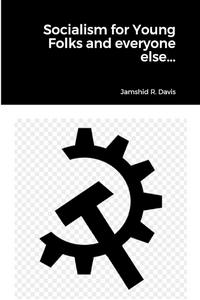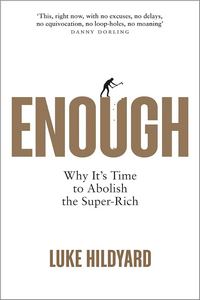Book reviews – Davis, Hildyard, Griffiths
 Socialism for Young Folks (and everyone else). By Jamshid R. Davis. Omnia Sunt Communia Press. 2023. 57pp.
Socialism for Young Folks (and everyone else). By Jamshid R. Davis. Omnia Sunt Communia Press. 2023. 57pp.
The Socialist Standard recently reviewed a booklet about anarchism aimed specifically at young people. The review was largely favourable and ended by suggesting that the Socialist Party might itself consider producing a similar publication about socialism ‘presenting in simple terms what is actually a very simple idea – organising the earth’s resources collectively and democratically on the basis of needs not profit’. We now discover that Jamshid Davishas actually got there first with a publication (Socialism for Young Folks) that comes extremely close to our own critique of current society and our proposals for changing it.
At the very start, he defines socialism as ‘an economic system where the means of production (how goods are made) and distribution (how goods get into the hands of those who need them) are socially owned in common’, and where ‘distribution is not through markets but by free access’. Having established what socialism is, he then proceeds to explain (and denounce) what it is not. It is not nationalisation or state ownership or control, since that is simply state capitalism, where ‘government managers take the place of the regular capitalist bosses’ and ‘wage labour, markets, and money still exist and there is no free access to needed goods or services’. An adamant ‘no’, therefore, to, the dictatorships in places like China, Cuba, Vietnam and North Korea. Nor do so-called ‘national liberation struggles’ have anything to do with socialism, since they ‘never were anti-capitalist in the first place’ and ‘socialism is by its very nature a world system’.
The class nature of the capitalist society we live in and that dominates the world is then analysed succinctly and effectively (‘a class is a group of people united by their common interests within the economic order’; ‘those who own property or manage it have all the power within a society, while those who do not own property suffer, powerlessness, economic exploitation, and poverty’; ‘the working class is composed of folks who must sell their labour power to capitalists or to the state to be able to support themselves and their families’). The solution to such inequality, we are told, is the abolition of class society and ‘the construction of a classless society’. The historical perspective that then follows about the rise of capitalism as a social and economic order and in particular how it overcame feudalism is also interesting for the added dimension it gives to the situation the world’s workers find themselves in today and what they need to do to do to bring about change and create a new system of society. It points to how past systems of society have changed, even though, while they existed, they may have seemed permanent and everlasting. Attention is also paid to the variety of noxious effects of the capitalist system on all who live under it. This includes a short but penetrating analysis of the various kinds of alienation it visits on its subjects and the way it stymies creative potential, the inevitability of crises of overproduction known as recessions or slumps, and the system’s tendency to cause military conflict through the struggle for markets’ (‘the First and Second World Wars can best be seen as a struggle between the various capitalist blocs over the division of the world market’).
What we have here, therefore, is an analysis and prescriptions found relatively rarely among who label themselves socialist but who are in fact using the word to mean variations, proposed or otherwise, on how to run capitalism. Having said that, there are, nevertheless, certain aspects of this booklet’s thesis that we would find it difficult to agree with. These occur largely in the section entitled ‘The Road Yet Travelled’, where a fairly detailed recipe for bringing about socialism and then organising it is put forward. It would be established, it argues, by acts of workplace protest, local democratic self-organisation and, above all, by direct action, which is likely to involve violence, since, the author insists, the capitalist class will never willingly give up their wealth and their protectors, the state, will never allow the system to be overturned and a new one established democratically via elections. So the strategy advocated here rejects the kind of democratic political action via the ballot box that the Socialist Party sees as the most fertile route to the establishment of a democratic, moneyless, marketless society once the necessary spreading of consciousness of the need for this has been achieved. Without this particular form of direct action (ie, the ballot box), it is difficult to see how a socially conscious working class can take the power necessary to abolish capitalism and set about organising a genuine socialist society. Nor is it a given, as suggested here, that, once the overwhelming majority of class-conscious workers have indicated their desire to establish socialism, there will be armed resistance from the capitalist class and their governments. So there is a clear difference in ‘strategy’ here between the author’s view and that of the Socialist Party on the establishment of socialism, even if the desired result seems very much the same.
In addition to this, the author goes in for a fairly detailed blueprint for how the new non-market, free access society will be organised, stating firmly, in the tradition of ‘Council Communism’, that it will be based on ‘workers’ councils’. Again we would see this as no more than one hypothesis out of many other possible ones and would argue that, once a majority of workers opt for a society without money, buying and selling, and wage and salary work, they will formulate their own way of organising it. All we can say is that they will do this democratically, via voluntary cooperation and using the knowledge, resources and technologies available at the time.
Despite these differences of view, however, there can be no doubt about the value of this publication both for the ideas it puts forward and for the clarity with which they are stated. It is helpful, above all, in putting centre-stage the idea the Socialist Party itself has been propagating for 120 years – that of dispensing with capitalism and establishing a new society based on collective production for direct use. As the author himself puts it – and we could not agree more –, ‘a world community is now possible and is necessary for the further development of humanity’.
HKM
Limitarianism
 Enough. Why It’s Time to Abolish the Super-Rich. By Luke Hildyard. Pluto Press. 2024
Enough. Why It’s Time to Abolish the Super-Rich. By Luke Hildyard. Pluto Press. 2024
Luke Hildyard, director of the think-tank the High Pay Centre, shows that the super-rich (the top 1 percent) don’t need most of their income and refutes all the arguments that they deserve it all. He also shows that, if they were reduced to being merely rich (a maximum income of £187,000 a year), then there would be enough money available for other uses, in particular improving the standard of living of others. This, he says, could be done both by redistribution (taxation) and by what he calls ‘pre-distribution’ (preventing too much income going to them in the first place). An average figure of around £2,500 a year per adult for everyone else is floated at one point. The money is definitely there but could it be diverted in the way he wants?
He favours the money going mostly to those currently with the lowest incomes. In fact, he sees the amount available being enough to ‘eliminate poverty pay at a stroke’. This would be done by raising the minimum wage, which, by reducing profits, would prevent so much income flowing to the super-rich.
But that’s not how the capitalist system works. It runs on profits and any reduction in profits would reduce the incentive and the amount to invest and risk proving an economic slowdown if not a recession. On the other hand, the aim of capitalist production is not the consumption of the rich owners of productive resources. It is the accumulation of profits as more and more capital invested for profit. In this sense, a disproportionate amount of profits going to the super-rich to spend on a personal super-luxurious lifestyle (yachts, private jets, bunkers, 40-bedroom mansions, lavish parties, etc) is a drag on capital accumulation. This in fact is what Hildyard argues in chapter 3 on ‘The Economic Case for Equality’, though a better title would have been ‘The Capitalist Case for Less Income Inequality’ since that’s what in effect he is arguing for.
Two other ‘pre-distributive’ measures that he advocates are worker-directors and profit-sharing. He thinks that workers on the board is likely to mean less exorbitant executive salaries. Maybe, but that wouldn’t mean that the money saved would go to increase wages. Profit-sharing is a snare which, besides tying workers to their employers, also means that they have an unpredictable income from year to year rather than a secure contracted amount.
As to the money raised by taxing the consumption income of the super-rich, this could in theory be used to provide improved public services and amenities but, capitalism not being geared to meeting people’s needs, is more likely to be used to reduce taxes on businesses or spent on capitalist priorities such as the armed forces.
Capitalism is based on the exclusion of the vast majority of the population from the ownership of productive resources, thereby obliging them to get a living by working for the tiny minority which does own them. Inequality in the ownership of productive resources is thus built into the system. This results in inequality in incomes too since profits are shared by a small number, giving each a high income. As capital accumulates, through the reinvestment under the pressure of competition of most profits, so does the wealth and income of the owners. The tendency, then, is for the rich as a whole to get richer. Reformist measures to redistribute wealth and income are up against this tendency which wins out in the long run.
Despite its naive reformism, the book is very readable and, as you would expect from the director of a think-tank devoted full-time to the issue, is well researched and referenced and so a useful source of information on the inequality of income and wealth ownership built into capitalism.
ALB
 ‘The Gleam of Socialism’. By Robert Griffiths, Praxis Press, 2004.
‘The Gleam of Socialism’. By Robert Griffiths, Praxis Press, 2004.
Why is there still a Communist Party? Good question. After all, the main role of that party throughout its history was to win support amongst workers for the foreign policy of the old USSR and its rulers. In fact, that’s why that state helped the finances of the party until the late 1970s, either directly or by buying thousands of copies of the old Daily Worker and its successor, the Morning Star.
No doubt, the leaders of the party weren’t just useful idiots but had sincerely convinced themselves that Russia was on the road to socialism and that in serving the interests of the USSR they were furthering the cause of socialism. But it wasn’t socialism. Far from it. It was a one-party dictatorship, the aim of whose rulers was to develop capitalism, in the form of a state capitalism, as rapidly as possible; which inevitably involved the economic exploitation of the workers there through the wages system and the extraction of surplus value. But this is the view of those Griffiths describes as ‘ultra-left anti-communists’.
Griffiths is the current general secretary of the ‘Communist Party of Britain’ (CPB), formed as a breakaway in 1988 from the historic ‘Communist Party of Great Britain’ whose leaders were indeed coming to the conclusion that there was no longer a need for a party dedicated to taking a lead from the rulers of the USSR. When the state-capitalist regime there finally collapsed in 1991 they decided to change the party’s name, to Democratic Left. Confusing matters, a grouplet, opportunistically, immediately took up the name and still exists under that name, publishing the Weekly Worker. This current CPGB has nothing to do with the historic party of that name. The original CPGB’s legitimate political successor can be said to be the CPB and the Morning Star.
There is also a previous breakaway, for the same sort of reason, in 1977 to form the still extant ‘New Communist Party’ which might have been able to claim this if they had not decided to link up with North Korea.
Griffiths’s book is a collection of articles, some of them published previously including short pieces on various well-known past CP members, mainly from Wales, from where he himself hails. The more substantial part is a history of the old CPGB — and its various policy twists and turns — and is accurate enough factually. It’s the explanation for them that is at fault as he presents them as being made in response to changes in conditions in Britain rather than at the behest of Moscow. Nor is there any reason to doubt the accuracy of his blow-by-blow account of the struggle in 1980s between the Old Guard CPers, centred around the Morning Star, and the ‘Eurocommunists’ who had won control of the party apparatus and who wanted to turn the party into a coalition of social movements, a sort of democratic green feminist left, and who were indeed ‘revisionists’ and ‘liquidationists’ from the Old Guard’s point of view.
The main reason for accepting the CPB as the political successor of the old CPGB is the continuity of political analysis which Griffiths illustrates. The CPB still sees the old USSR as having been socialist and still analyses present-day capitalism as ‘state-monopoly capitalism’ and still sees the way forward as a broad alliance of all anti-monopoly elements led by the ‘united working class movement’ to elect a left-wing Labour government. The aim, in other words, is an economy with a state-capitalist sector and a fairly extensive private non-monopoly sector under a reformist government.
Perhaps surprisingly, Jeremy Corbyn is described as a ‘longstanding friend of the Communist Party’. Maybe he just sees them as general Old Labour left-wing reformists like himself.
ALB
Next article: 50 Years Ago – Labour Government: The Worst of Illusions ⮞
One Reply to “Book reviews – Davis, Hildyard, Griffiths”
Leave a Reply
You must be logged in to post a comment.

Thanks for the review of my booklet. I am currently working on a 2nd edition which will mostly concentrate on the main lead article and incorporate the other sections as additional questions. Also cutting out sections which may appear to be more pro-violence than intended. There is no one way to socialism.